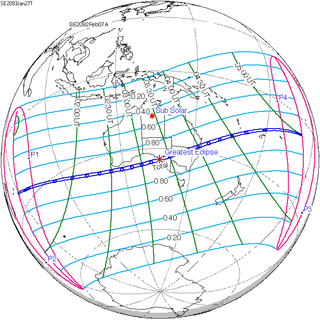| Solar eclipse of January 27, 2093 | |
|---|---|
| Type of eclipse | |
| Nature | Total |
| Gamma | −0.2737 |
| Magnitude | 1.034 |
| Maximum eclipse | |
| Duration | 178 s (2 min 58 s) |
| Coordinates | 34°06′S 136°24′E / 34.1°S 136.4°E |
| Max. width of band | 119 km (74 mi) |
| Times (UTC) | |
| Greatest eclipse | 3:22:16 |
| References | |
| Saros | 142 (27 of 72) |
| Catalog # (SE5000) | 9716 |
A total solar eclipse will occur at the Moon's descending node of orbit on Tuesday, January 27, 2093,[1] with a magnitude of 1.034. A solar eclipse occurs when the Moon passes between Earth and the Sun, thereby totally or partly obscuring the image of the Sun for a viewer on Earth. A total solar eclipse occurs when the Moon's apparent diameter is larger than the Sun's, blocking all direct sunlight, turning day into darkness. Totality occurs in a narrow path across Earth's surface, with the partial solar eclipse visible over a surrounding region thousands of kilometres wide. Occurring about 1.3 days after perigee (on January 25, 2093, at 18:45 UTC), the Moon's apparent diameter will be larger.[2]
The path of totality will be visible from parts of Australia, New Caledonia, and Vanuatu. A partial solar eclipse will also be visible for parts of Antarctica, Australia, Indonesia, and Oceania.
- ^ "January 27, 2093 Total Solar Eclipse". timeanddate. Retrieved 24 August 2024.
- ^ "Moon Distances for London, United Kingdom, England". timeanddate. Retrieved 24 August 2024.
